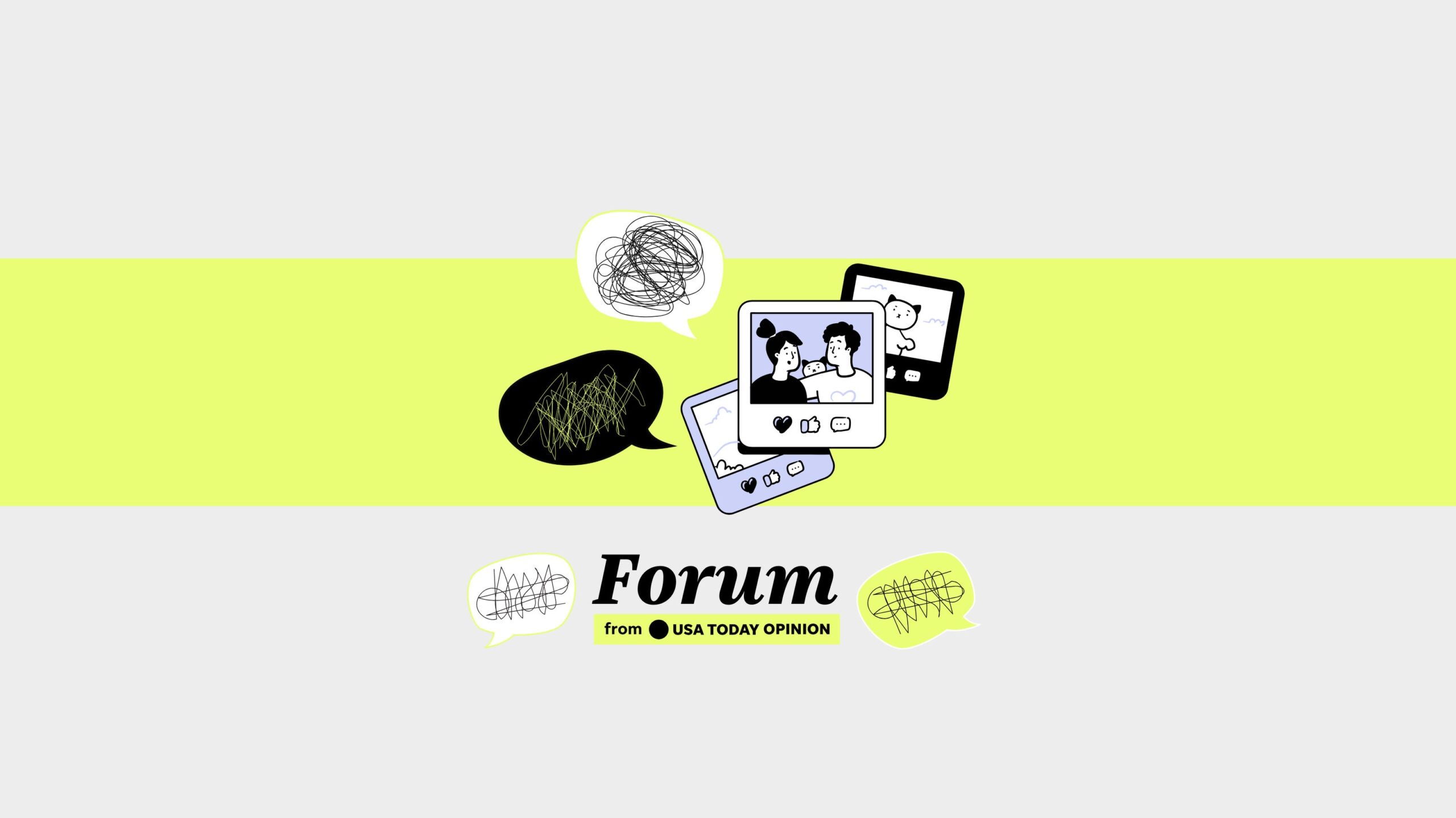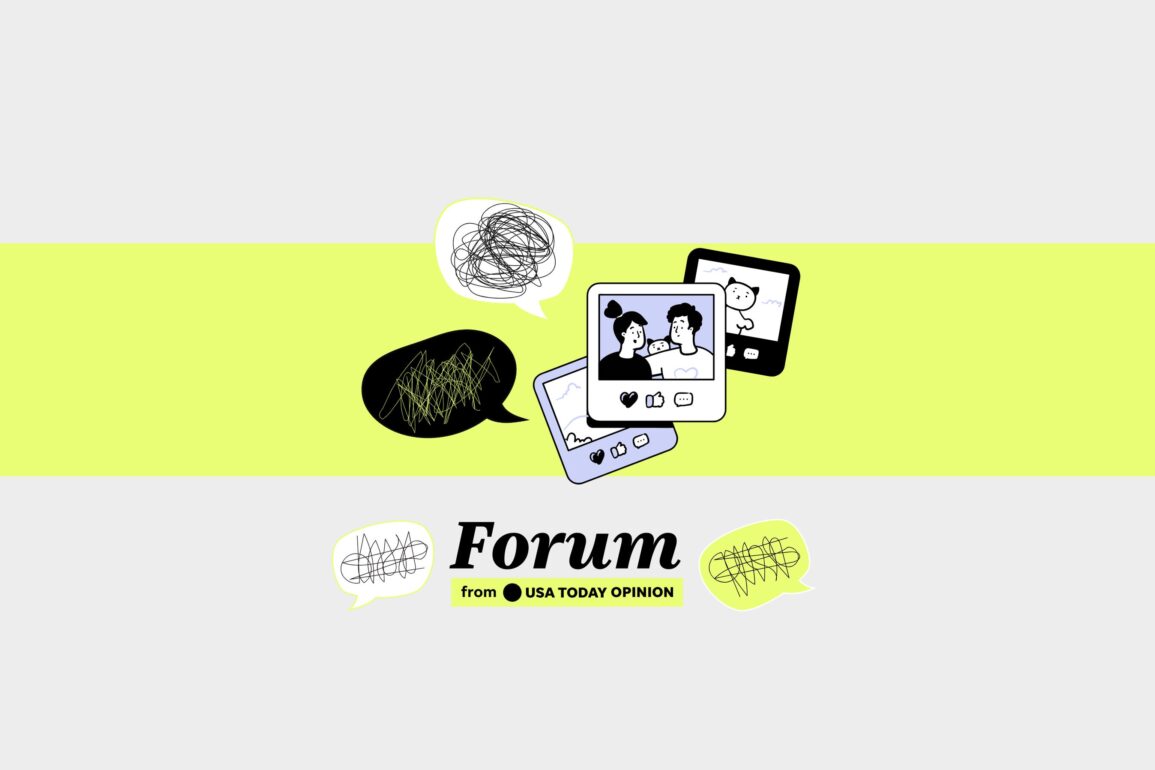
What should parents and caregivers consider when it comes to social media and technology?
It’s a big question – with many answers. Let’s face it: As parents, we’re making a lot of this up as we go along and the speed of new tech doesn’t make it any easier. It seems like just when we get caught up to something there’s a new social media site to worry about or a new study that sends us asking the internet – and our fellow caregivers – what should we do?
Should your kid have a phone in case of emergencies? How early is too early for an iPhone? Are educational shows and streamers OK? Does my kid have a burner social media account like I see on “Euphoria” – and what are they really posting on Snapchat?
But rather than turn to MomTok or the group chat, we wanted to hear from you. How do you handle social media and smartphones when it comes to your kids? Here’s what you said.
Take part in our next Forum:Tell us what free speech means to you at a time when that’s up for debate | Opinion
Need a break? Play the USA TODAY Daily Crossword Puzzle.
I’m a middle-school teacher. I’ve watched how too much tech changes kids’ ability to solve problems.
As new parents, my wife and I were instantly faced with the decision on what role technology will play in my daughter’s life. In those early, sleep-deprived days and late nights, technology companies invade your algorithmic feeds with products and services promising to ease your pain.
For a parent trying to catch a break, you’d be crazy not to give into the temptation of a bassinet that will rock your baby to sleep or subscribing to Ms. Rachel, who will teach your child while you catch up on work at Starbucks. These “parenting hacks” were not an option for us because we’ve both been teachers for the last nine years.
I’m a video production teacher, so technology has always been embedded in my subject, and so have been the temptations for my students to be distracted by it. In my second year teaching, I had a student who would open a new tab on his browser to play games anytime I left his side. When I called his mom about his behavior, she told me that she had taken away his phone and locked it in a closet and that he used a screwdriver to take off the door to get his phone back. Scenes reminiscent of the heroin addicts in “Requiem for a Dream” were not the norm, but as technology creeps deeper into the lives of our children their clear dependency on it is.
Students lack the attention span and resilience they had just a handful of years ago. I’ve been using “Star Wars: A New Hope” as our text to breakdown the hero’s journey since my first year teaching. I don’t expect every student to love or even like the film, but it’s only in the last couple of years where I’ve had whole classes struggle to maintain their attention throughout.
The foundational skill I teach to my middle-school students is editing on Adobe Premiere. Teaching this age group to edit on professional-level software is not an easy task, but it certainly can be done. This type of project-based learning requires a base-level of perseverance and initiative to try to work things out when they aren’t sure about what to do next. However, the number of students who exhibit learned helplessness is on the rise. It’s not a majority of students, but the number of students who give up when they hit the first roadblock and won’t do anything until I basically do it for them is at an all-time high.
I believe wholeheartedly that this is a result of our on-demand culture that’s exemplified by apps that allow you to swipe away anything that doesn’t provide instant gratification. Every time I see a tablet or phone in front of a child’s entranced face at a restaurant or, God forbid, a shopping cart in the store, I think about the uncomfortable conversations and meetings you’ll be having with your child’s future teachers.
— Daniel Shutler-Ojeda, San Diego, California
With younger kids, I’m setting tech boundaries early to give them healthier relationships as teens
I limit my three kids (ages 7, 5 and 3) to less than 90 minutes of screen time per day (educational kid shows only ‒ no video games or handheld devices). It’s structured – after school and after they’ve completed chores ‒ so that they can anticipate the usage but also know that it’s limited. It isn’t much of a fight in our household. It forces our kids to play with each other, their toys and outside.
They can have limited use in the car, then they have to read a book or listen to kid podcasts. They have good attention spans and can entertain themselves. Their teachers appreciate their engagement at school.
Opinion: I banned TikTok and other social media for my kids. And I don’t regret it
Opinion: Technology is terrible, but I gave my kid an iPhone anyway. I think it’s OK.
My kids are still too young for social media, but I don’t see much benefit at all. I myself quit Facebook and Instagram in the last three years for my own mental health. I probably won’t let them use social media until 16 years old, and even then on a very limited basis, maybe 15 minutes a day. I would advise other parents to preserve their kids’ self-esteem and exposure, and limit kids’ social media until 16 or older and have frequent check-ins about their usage. I plan on having my kids turn in their smartphones and devices at the end of the night, and never be alone in a room with them.
— Jill Piercy Larsen, Royal City, Washington
I’m 16. Some boundaries around social media are actually a relief.
When the Supreme Court recently upheld the law banning TikTok, I thought I’d despair. But to be honest, I breathed a sigh of relief.
As a 16-year-old, I average six hours of screentime on weekdays, eight during the weekend. Like many my age, I’ve watched TikTok slowly absorb my life and the lives of everyone around me. I’ve watched it glue the eyes of my friends to their screens during dinners, lunches at school, anytime we were together. I’ve watched it become the one thing I hated but couldn’t live without.
I still recall the first time it hit me that all this time on TikTok was becoming an issue. Something like two or three years ago, Christmas Eve, a few friends and I were hunkering down at a small café up until midnight. It had been a good evening ‒ eating dinner at a Korean place, visiting the Christmas markets, having the good kind of time you’d expect us teenagers to have.
Inside the café, we made our way to the back and took our seats. At the time, this was the kind of evening I always looked forward to. With friends I loved, people I cared for, and plenty more hours to chill and chat.
And yet, before I could bring any words of conversation to my lips ‒ how they were doing, what they thought of the new movie, what was going on between my friend and this guy she kept seeing ‒ their hands had already swooped down to their phones, screens flickering, eyes locked in. I can still recall them turning up the volume on the videos they would continue to play for the next 2 1/2 hours.
At the time, I couldn’t remotely fathom the draw of those TikTok cat videos or TikTok dances over the friends who were right next to them. But whatever the appeal was, it was far beyond my pleas of “c’mon guys, it’s Christmas Eve” or “guys, please, just for a couple minutes?”
To say the least, it didn’t take long for them to forget about everything around them. And everyone.
That was a few years back. Now, as a full-fledged teenager, I’ve witnessed firsthand the effects of social media addiction. The low self-esteem, anxiety, depression ‒ I’ve seen too many of my friends, myself included, get lost in never-ending feeds of videos, create albums filled with hundreds of attempts at the perfect selfie, scroll infinitely down that TikTok feed with each video telling ourselves it’s “the last one.”
I know there’s a part of me ‒ and I’m sure I speak for my friends as well ‒ that’s annoyed at ourselves. In some ways, we’re all hoping we’re capable of giving ourselves that final shove we need to quit.
— Alex Wang, Massachusetts
Adding gasoline to a fire of emotions
It’s just incredibly hard. I watch my teenagers fidget with their iPhones constantly. I can see it as clearly as gasoline being added to a fire of emotions, mostly anxiety and self-doubt. Their finger constantly taps rapidly to their phone, tapping through each Snap or message or reel, and I can see in their faces they’re not OK.
None of it brings them joy, but is a race to have the most Snap streaks or to escape from whatever. As parents we try to take away the apps or drastically limit time on them, but they see it as punishment. They’re good kids, follow the rules and are kind. Why are they “punished” when they see every other kid being on their phone way more and have no limitations?
It’s a struggle every. single. day.
— Nicole Mundinger, South Lyon, Michigan
As a parent and an educator, I see the grip technology has on kids. It’s time schools start treating it like an addiction.
I’m the parent of two boys, ages 18 and 15, plus I’m also a fifth-grade teacher.
They’ve had computers since the schools sent them home during COVID-19, when they were in the fifth and eighth grades.
We had a computer the boys could share at home before the pandemic. My husband is in computers and sees nothing wrong with computer games or spending hours on them, but I disagree. This has been a parenting battle with us.
The pandemic and computers being sent home is awful for parents, because we have lost control of what our kids have. School districts do not lock down computers enough. Parents can request schools not send home the computer or lock it down, only to be told it has all their school work on it. This also helps bullying to flourish online.
As a teacher we ask that computers be locked at school, especially in elementary school, only to be told no by district officials. Less homework gets done now that computers are sent home. Less reading, writing and math. Mostly less thinking.
Our solution: We bought our children their own computers that we can lock down and signed a waiver at school.
As a teacher, I am seeing serious addiction to technology where kids will break into locked drawers to get their computer after they have misused it. Students who can’t stay off YouTube even for one minute or not ask AI questions about every move they want to make, from playing to drawing.
Phones are their own problem. Both boys got them when they entered junior high and already in an awful time. I think the phones made it worse.
We monitored our kids’ every key stroke. I’m on every one of my kids’ accounts (or was, until my oldest turned 18). We still monitor my youngest, who, when he started had Snapchat, Instagram, Facebook, YouTube and TikTok. He took himself off TikTok, Snapchat and Facebook this year saying they were not interesting anymore.
When we realized technology was a problem, we made both boys take a sexual harassment class and a technology class. Both their dad and I sat in. I think the classes helped them see what could happen on social media.
Yes, I worry intently about their use of technology and how it will affect them. However it isn’t going away, so training to make good decisions is important. My biggest concern is what it is doing to our brains and how lazy artificial intelligence has made kids. I’m worried that kids are not using their brains, which is a muscle. Like all muscles not used, they will become weak.
Parents, please be aware that technology, like anything else, can be an addiction ‒ like smoking, cocaine or alcohol. Unfortunately, schools let kids who are addicted to technology be in the same room as their addiction.
— Debra Williams, Citrus Heights, California
This post was originally published on this site be sure to check out more of their content








